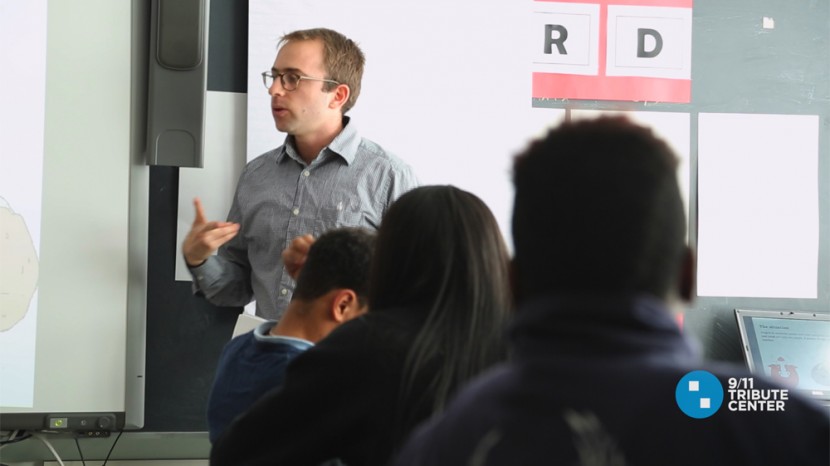This teacher addresses the topic of terrorism as a global issue, and then brings the focus specifically to 9/11. He looks at a primary document released by Al Qaeda and asks the students to think about terrorists who say their actions are motivated by religious belief.
Responding to Terrorism

Responding to Terrorism
Responding to Terrorism
Steven Seltz, Urban Assembly School for Law and Justice, Brooklyn, NY
Global Issues
Grade level: 12
Number of class periods: 1
Objective
Terrorism is a challenge in countries around the world. In each instance, terrorists have different and specific motives. How have different governments tried to protect their citizens from terror attacks?
Resources
- Al Qaeda’s Second Fatwa - PDF
- “Responding to Terrorism: Challenges for Democracy, 7th ed., ” The Choices Program - PDF
- Investigating Bin Laden Handout - PDF
Common Core Standards
Comprehensive Common Core Alignments at end of lesson plan.
- Reading Standards for Literacy in History/Social Studies 1, 2, 3, 9
- Writing Standards for Literacy in History/ Social Studies, Science, and Technical Subjects 1
Preparation
Prior to this lesson, students will be assigned an excerpt from Responding to Terrorism: Challenges for Democracy, a publication of The Choices Program.
Students will read the section entitled, “What common factors help explain the motivations and methods of religious terrorists?” (pp. 5 – 6). This reading is meant to develop background knowledge for students on the issues of the root causes of religiously-motivated terrorism.
Activity
Mini lesson
As a warm-up, have students respond to the following question: If you were to tell the story of the September 11, 2001 terrorist attacks, where would you begin? Would you begin on the day of the attacks? The day before?
Short lecture on key events in preceding decades to Sept 11 attacks, focusing on development of Al Qaeda: development of mujahedeen fighting forces in Afghanistan as response to Soviet Union invasion; role of Osama Bin Laden in supporting mujahedeen forces; development of Taliban government after withdrawal of Soviet Union in 1990s.
Group discussion
Explain for class that, at one time, Osama Bin Laden and United States seemed to have a common enemy – the Soviet Union – yet by 1998, Bin Laden and Al Qaeda had declared “war” on the US. The challenge today will be to figure out why, using Bin Laden’s own words as a clue. Read the statement, issued on February 23, 1998, by Al Qaeda, in which the group presents its major issues against the United States and its allies. As a group, annotate for what you see as Bin Laden’s central ideas. Answer the following question: What does this documents reveal to us about Bin Laden’s thinking and the motivations of Al Qaeda? Based on Bin Laden’s words, what steps would you recommend the United States take to protect its citizens from terror attacks?
Assessment / Reflection
Imagine that the year is 1998. You have been hired by President Bill Clinton and the CIA to analyze Al Qaeda’s organization. Using the writings that you and your group just analyzed, prepare a briefing for the president, detailing Bin Laden’s key ideas, and proposing a strategy for dealing with him and Al Qaeda.
Common Core Alignments
12th Grade Social Studies Elective. This lesson can be adjusted for other grade levels and subjects. It aligns with the following Common Core Standards:
Reading Standards for Literacy in History/ Social Studies
Key Ideas and Details
Standard 1: Cite specific textual evidence to support analysis of primary and secondary sources, connecting insights gained from specific details to an understanding of the text as a whole
- Students will be using specific textual evidence to support analysis of both the primary source document (the second Fatwa) and the secondary source documents about responding to terror to analyze and draw conclusions about the motivations of religious extremists and how governments have responded and should respond to the threat of terror.
Standard 2: Determine the central ideas or information of a primary or secondary source; provide an accurate summary that makes clear the relationships among the key details and ideas.
- Students will be using Osama bin Laden’s second Fatwa to determine the central ideas of Al Qaeda’s creed. They will need to find specific textual evidence to support their decisions about what Al Qaeda’s central ideas are and will use those ideas to form an argument about how the United States should respond.
Standard 3: Evaluate various explanations for actions or events and determine which explanation best accords with textual evidence, acknowledging where the text leaves matters uncertain.
- Students will be exposed to several different sources from the Choices program about how governments respond to terrorism and its implications for democracy. They will also be evaluating these sources, in conjunction with the second Fatwa, in order to determine the best response the U.S. government can make.
Integration of Knowledge and Ideas
Standard 9: Integrate information from diverse sources, both primary and secondary, into a coherent understanding of an idea or event, noting discrepancies among sources.
- Students will be reading several different accounts of government responses to religious extremism and terrorism, and will be using these documents as well as the second Fatwa in order to have a more coherent understanding of the beliefs and motivations of religious extremists and how governments respond.
Writing Standards for Literacy in History/ Social Studies, Science, and Technical Subjects
Text Types and Purposes
Standard 1: Write arguments focused on discipline-specific content.
- Students will be using their readings and the evidence they gather from both the primary and secondary sources in order to make a recommendation to the United States government about its best response to terrorism.
